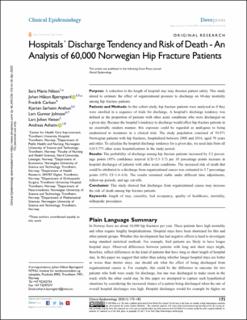| dc.contributor.author | Nilsen, Sara Marie | |
| dc.contributor.author | Bjørngaard, Johan Håkon | |
| dc.contributor.author | Carlsen, Fredrik | |
| dc.contributor.author | Anthun, Kjartan Sarheim | |
| dc.contributor.author | Johnsen, Lars Gunnar | |
| dc.contributor.author | Vatten, Lars Johan | |
| dc.contributor.author | Asheim, Andreas | |
| dc.date.accessioned | 2020-04-06T09:25:46Z | |
| dc.date.available | 2020-04-06T09:25:46Z | |
| dc.date.created | 2020-02-19T09:04:22Z | |
| dc.date.issued | 2020 | |
| dc.identifier.citation | Clinical Epidemiology. 2020, 12 173-182. | en_US |
| dc.identifier.issn | 1179-1349 | |
| dc.identifier.uri | https://hdl.handle.net/11250/2650463 | |
| dc.description.abstract | Purpose: A reduction in the length of hospital stay may threaten patient safety. This study aimed to estimate the effect of organizational pressure to discharge on 60-day mortality among hip fracture patients.
Patients and Methods: In this cohort study, hip fracture patients were analyzed as if they were enrolled in a sequence of trials for discharge. A hospital’s discharge tendency was defined as the proportion of patients with other acute conditions who were discharged on a given day. Because the hospital’s tendency to discharge would affect hip fracture patients in an essentially random manner, this exposure could be regarded as analogous to being randomized to treatment in a clinical trial. The study population consisted of 59,971 Norwegian patients with hip fractures, hospitalized between 2008 and 2016, aged 70 years and older. To calculate the hospital discharge tendency for a given day, we used data from all 5,013,773 other acute hospitalizations in the study period.
Results: The probability of discharge among hip fracture patients increased by 5.5 percentage points (95% confidence interval (CI)=5.3– 5.7) per 10 percentage points increase in hospital discharges of patients with other acute conditions. The increased risk of death that could be attributed to a discharge from organizational causes was estimated to 3.7 percentage points (95% CI=1.4– 6.0). The results remained stable under different time adjustments, follow-up periods, and age cut-offs.
Conclusion: This study showed that discharges from organizational causes may increase the risk of death among hip fracture patients. | en_US |
| dc.language.iso | eng | en_US |
| dc.publisher | Dovepress | en_US |
| dc.rights | Navngivelse-Ikkekommersiell 4.0 Internasjonal | * |
| dc.rights.uri | http://creativecommons.org/licenses/by-nc/4.0/deed.no | * |
| dc.title | Hospitals' Discharge Tendency and Risk of Death - An Analysis of 60,000 Norwegian Hip Fracture Patients | en_US |
| dc.type | Peer reviewed | en_US |
| dc.type | Journal article | en_US |
| dc.description.version | publishedVersion | en_US |
| dc.source.pagenumber | 173-182 | en_US |
| dc.source.volume | 12 | en_US |
| dc.source.journal | Clinical Epidemiology | en_US |
| dc.identifier.doi | 10.2147/CLEP.S237060 | |
| dc.identifier.cristin | 1795645 | |
| dc.description.localcode | This work is published and licensed by Dove Medical Press Limited. The full terms of this license are available at https://www.dovepress.com/terms.php and incorporate the Creative Commons Attribution - Non Commercial (unported, v3.0) License. By accessing the work you hereby accept the Terms. Non-commercial uses of the work are permitted without any further permission from Dove Medical Press Limited, provided the work is properly attributed. For permission for commercial use of this work, please see paragraphs 4.2 and 5 of our Terms. | en_US |
| cristin.ispublished | true | |
| cristin.fulltext | original | |
| cristin.qualitycode | 1 | |

